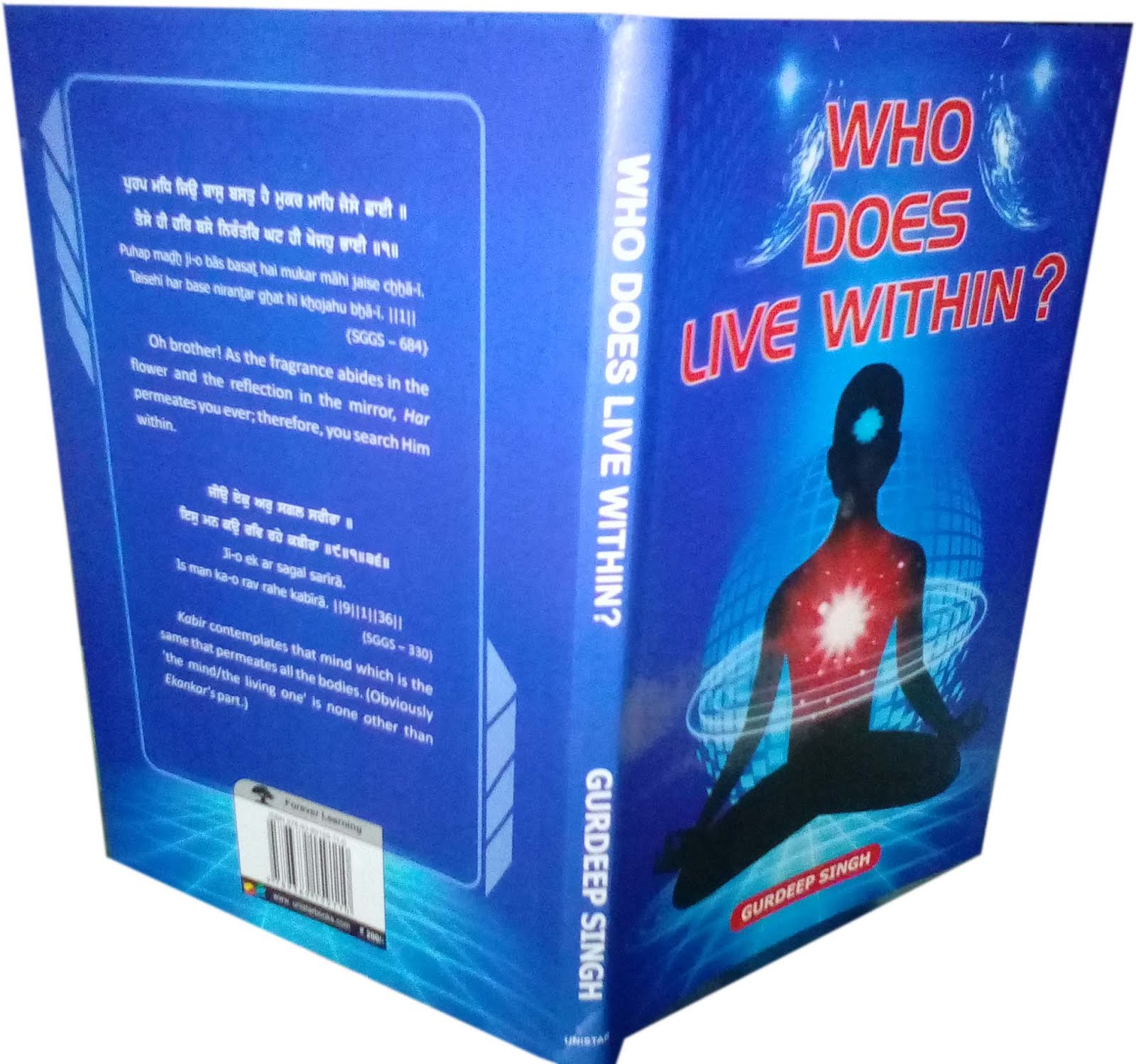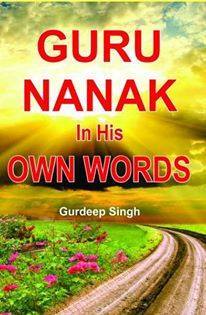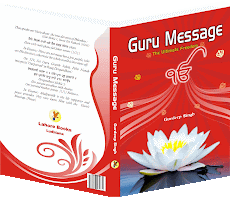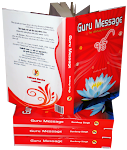20150104
The Mystery Behind The Death
In the Gurmat academic arenas, the scholars wrestle hard to prove their points; in their game, they do bad mouthing against those, who take the liberty of having different point of view regarding some concepts expressed in the Gurbani. Most of them are reluctant to agree on this that if interpreting the Gurbani basing on the Vedic approach is wrong, interpreting the Gurbani under the influence of western thought is not right either. By pondering over the Gurbani without having any outer influences, one feels amazed to know how the Guru expresses the secrets of the Creator’s existence. First Nanak on 152, SGGS, in very subtle away, explains the existence of the Creator; he portrays the existence of one’s independent identify created by one’s self-conceit. It is the picture, which can be fully visualized by the experience First Nanak had. We are all just trying to build a pyramid of words based upon our guesses totally empty from any solid experience. Let us look at that shabda and go into its depth by taking off the gowns of our outer influences without coining new meaning for the well-established words used in the Gurbani. Also we should eradicate our self-conceit built on our own selfish agendas to see what our Guru has explained us, because it is our self-conceit that pushes us on a faulty path not applauded by our Creator as per the Gurbani, kindly look at the following:
ਪਉੜੀ ॥
ਜਜਾ ਜਾਨੈ ਹਉ ਕਛੁ ਹੂਆ ॥ ਬਾਧਿਓ ਜਿਉ ਨਲਿਨੀ ਭ੍ਰਮਿ ਸੂਆ ॥
ਜਉ ਜਾਨੈ ਹਉ ਭਗਤੁ ਗਿਆਨੀ ॥ ਆਗੈ ਠਾਕੁਰਿ ਤਿਲੁ ਨਹੀ ਮਾਨੀ ॥
ਜਉ ਜਾਨੈ ਮੈ ਕਥਨੀ ਕਰਤਾ ॥ ਬਿਆਪਾਰੀ ਬਸੁਧਾ ਜਿਉ ਫਿਰਤਾ ॥
ਸਾਧਸੰਗਿ ਜਿਹ ਹਉਮੈ ਮਾਰੀ ॥ ਨਾਨਕ ਤਾ ਕਉ ਮਿਲੇ ਮੁਰਾਰੀ ॥੨੪॥
Pa▫oṛī.
Jajā jānai ha▫o kacẖẖ hū▫ā. Bāḏẖi▫o ji▫o nalinī bẖaram sū▫ā.
Ja▫o jānai ha▫o bẖagaṯ gi▫ānī. Āgai ṯẖākur ṯil nahī mānī.
Ja▫o jānai mai kathnī karṯā. Bi▫āpārī basuḏẖā ji▫o firṯā.
Sāḏẖsang jih ha▫umai mārī. Nānak ṯā ka▫o mile murārī. ||24||
{SGGS-255}
Stanza.
In essence: A person thinks that he has become something, actually he is bound by doubts like a parrot in a trap. Our Master doesn’t care about that person, who claims to be knowledgeable devotee. When one thinks that one can preach well, one is just like a peddler wandering around; however, that person who eliminates his conceit in the association of His Sants meets Ekankar
In the following shabda on 152, SGGS, First Nanak explains about the cause of the existence of body; he explains also that it is the higher state of mind through which it is understood what is in the body that keeps it alive and why that one doesn’t die? How does Prabh’s presence remain in it? Literally, it is the self-conceit of the mortal that creates problem and ruins his or her peace, but the soul and its source, the Creator’s force, has no end.
First the Guru invites the intellectuals to ponder over a mystery:
ਗਉੜੀ ਮਹਲਾ ੧ ॥
ਪਉਣੈ ਪਾਣੀ ਅਗਨੀ ਕਾ ਮੇਲੁ ॥ ਚੰਚਲ ਚਪਲ ਬੁਧਿ ਕਾ ਖੇਲੁ ॥
ਨਉ ਦਰਵਾਜੇ ਦਸਵਾ ਦੁਆਰੁ ॥ ਬੁਝੁ ਰੇ ਗਿਆਨੀ ਏਹੁ ਬੀਚਾਰੁ ॥੧॥
Ga▫oṛī mėhlā 1.
Pa▫uṇai pāṇī agnī kā mel. Cẖancẖal cẖapal buḏẖ kā kẖel.
Na▫o ḏarvāje ḏasvā ḏu▫ār. Bujẖ re gi▫ānī ehu bīcẖār. ||1||
Raag Gaurhi, the bani of First Nanak.
In essence: The body is a union of air, water, and fire; the fickle mind plays in it with its intellect. In it are nine openings and a door known as “the tenth door.” Oh wise man! Reflect on this!
We are well versed about the anatomy of the body save for the tenth door the Guru indicates in the above verses and it is the main point in this mystery that remains unsolved for many of us. It is very important to understand the oneness of the Creator, who remains present within all the lives and beyond. In other words, in the body, it is not you or I but the all pervading Creator and it is our self-conceit that has established its own independent identity from the Creator. The word, soeI is used for the Creator in the below verses:
ਕਥਤਾ ਬਕਤਾ ਸੁਨਤਾ ਸੋਈ ॥
ਆਪੁ ਬੀਚਾਰੇ ਸੁ ਗਿਆਨੀ ਹੋਈ ॥੧॥ ਰਹਾਉ ॥
Kathṯā bakṯā sunṯā so▫ī. Āp bīcẖāre so gi▫ānī ho▫ī. ||1|| rahā▫o.
It is Akalpurakh who speaks, teaches, and listens (with His presence within). The one who reflects on one’s “inner self” becomes wise (the Knower of the Creator). Pause.
To understand the above verses, we should also look at Fifth Nanak’s verses on 206, SGGS:
ਏਕ ਮਹਲਿ ਤੂੰ ਹੋਹਿ ਅਫਾਰੋ ਏਕ ਮਹਲਿ ਨਿਮਾਨੋ ॥
ਏਕ ਮਹਲਿ ਤੂੰ ਆਪੇ ਆਪੇ ਏਕ ਮਹਲਿ ਗਰੀਬਾਨੋ ॥੧॥
Ėk mahal ṯūʼn hohi afāro ek mahal nimāno.
Ėk mahal ṯūʼn āpe āpe ek mahal garībāno. ||1||
In essence: In one person, you are conceited one, but in other person, you are humble one. In one person, you have absolute power, but in other you have nothing (poor).
Thus the Guru expresses Prabh’s presence in all human beings (actually in all the lives.)
ਏਕ ਮਹਲਿ ਤੂੰ ਪੰਡਿਤੁ ਬਕਤਾ ਏਕ ਮਹਲਿ ਖਲੁ ਹੋਤਾ ॥
ਏਕ ਮਹਲਿ ਤੂੰ ਸਭੁ ਕਿਛੁ ਗ੍ਰਾਹਜੁ ਏਕ ਮਹਲਿ ਕਛੂ ਨ ਲੇਤਾ ॥੨॥
Ėk mahal ṯūʼn pandiṯ bakṯā ek mahal kẖal hoṯā.
Ėk mahal ṯūʼn sabẖ kicẖẖ garāhaj ek mahal kacẖẖū na leṯā. ||2||
In one person, you are a scholar and orator, but in other person, you are just a fool. In one person, you are the one, who grabs from others, but in other person, you take nothing.
Obviously, it is only the Creator, who is all in all: ਕਥਤਾ ਬਕਤਾ ਸੁਨਤਾ ਸੋਈ ॥
In the Gurbani, it is stressed that Prabh Naam is found within, but first one needs to understand one’s “inner self”. Usually one remains involved with one’s body only. It is expressed in the Gurbani that the “inner self” actually acts under the ordinance of the Creator; please see again on 206, SGGS, in the same very shabda of Fifth Nanak:
ਕਾਠ ਕੀ ਪੁਤਰੀ ਕਹਾ ਕਰੈ ਬਪੁਰੀ ਖਿਲਾਵਨਹਾਰੋ ਜਾਨੈ ॥
ਜੈਸਾ ਭੇਖੁ ਕਰਾਵੈ ਬਾਜੀਗਰੁ ਓਹੁ ਤੈਸੋ ਹੀ ਸਾਜੁ ਆਨੈ ॥੩॥
Kāṯẖ kī puṯrī kahā karai bapurī kẖilāvanhāro jānai.
Jaisā bẖekẖ karāvai bājīgar oh ṯaiso hī sāj ānai. ||3||
In essence: What the poor wooden puppets can do? Only the puppeteer knows what they will play. They play whatever the role the puppeteer makes them play.
It will be helpful in this context if we also read stanza number 33 of Japji on 7, SGGS
The soul is a part of the Creator’s light (Jyoti of jyot). Please read on 1187, SGGS, how the Guru addresses the part of Akalpurakh that exists in the body:
ਗਾਛਹੁ ਪੁਤ੍ਰੀ ਰਾਜ ਕੁਆਰਿ ॥
ਨਾਮੁ ਭਣਹੁ ਸਚੁ ਦੋਤੁ ਸਵਾਰਿ ॥
Gācẖẖahu puṯrī rāj ku▫ār.
Nām bẖaṇahu sacẖ ḏoṯ savār.
Oh soul! You are a daughter of Ekankar, the emperor; you go away from all this. Remember His name in the morning everyday.
When one understands completely how all this is put in work, one also realizes that it is only the Creator, who is staging the entire show of the world; if it is not realized, it is because of the duality one is enveloped in. It is very important to understand the word “duality”. In simple words, any act, or a thought, or a relation or an emotion that perceives the Creation and the Creator as two separate entities is a product of duality. Stress in the Gurbani is on the oneness of the Creator with His creation in which He overwhelmingly remains present. That is why Sikhi is a path not a religion of man-made dogmas and strict rules to control the believer.
The shabda continues:
Reread the first two verses and then analyze what is said in the “Rahao verses.” By doing so, it becomes clear that it is impossible to comprehend the Guru’s said mystery without experiencing what the Guru says.
ਦੇਹੀ ਮਾਟੀ ਬੋਲੈ ਪਉਣੁ ॥ ਬੁਝੁ ਰੇ ਗਿਆਨੀ ਮੂਆ ਹੈ ਕਉਣੁ ॥
ਮੂਈ ਸੁਰਤਿ ਬਾਦੁ ਅਹੰਕਾਰੁ ॥ ਓਹੁ ਨ ਮੂਆ ਜੋ ਦੇਖਣਹਾਰੁ ॥੨॥
Ḏehī mātī bolai pa▫uṇ. Bujẖ re gi▫ānī mū▫ā hai ka▫uṇ.
Mū▫ī suraṯ bāḏ ahaʼnkār. Oh na mū▫ā jo ḏekẖaṇhār. ||2||
In this body of soil, the breath goes in and out. O Wise one! Who has died then (This is the body that is called alive, but when the breath stops, who is the one, who dies?) The interest in strife, conceit, and Maya has died; however, one who sees all this doesn’t die.
In other words, one’s nature prone to strife, conceit and Maya dies; the body is made of soil and it merges in it and the breath merges with the air, but one, who watches all that show, doesn’t die.
In this context, it is advisable to read also on 188, SGGS, Fifth Nanak elaborates the same idea:
ਏਕਾ ਮਾਟੀ ਏਕਾ ਜੋਤਿ ॥ ਏਕੋ ਪਵਨੁ ਕਹਾ ਕਉਨੁ ਰੋਤਿ ॥੨॥
Ėkā mātī ekā joṯ. Ėko pavan kahā ka▫un roṯ. ||2||
In essence: All are made of the same soil. The same light of Akalpurakh exists in all and the same breath passes through all. (When the breath stops) Why and for whom one should cry?
In the above verses, in a very compact manner, Fifth Nanak sums up the idea given by First Nanak on 599 SGGS, in raag Sorath (ਤਤੁ ਨਿਰੰਜਨੁ ਜੋਤਿ ਸਬਾਈ ਸੋਹੰ ਭੇਦੁ ਨ ਕੋਈ ਜੀਉ ॥ Ŧaṯ niranjan joṯ sabā▫ī sohaʼn bẖeḏ na ko▫ī jī▫o. In essence: the immaculate Creator is the origin of all the lives and His light exists in all; therefore, there is no difference between Him and His creation”. (He says that we emanate from the same source and there is no real difference. Just because of our nature of duality, we always see all others different than one and another instead of accepting them as a part of the Creator we worship.). For the same part of the Creator, the Guru says:
ਮੇਰਾ ਮੇਰਾ ਕਰਿ ਬਿਲਲਾਹੀ ॥ ਮਰਣਹਾਰੁ ਇਹੁ ਜੀਅਰਾ ਨਾਹੀ ॥੩॥
Merā merā kar billāhī. Maraṇhār ih jī▫arā nāhī. ||3||
(When one dies, others bewail by calling “my relative has died”) The mortals bewail by calling the dead “mine” but they do not understand that the soul (a part of the Creator) doesn’t die.
ਕਹੁ ਨਾਨਕ ਗੁਰਿ ਖੋਲੇ ਕਪਾਟ ॥ ਮੁਕਤੁ ਭਏ ਬਿਨਸੇ ਭ੍ਰਮ ਥਾਟ ॥੪॥੪੩॥੧੧੨॥
Kaho Nānak gur kẖole kapāt. Mukaṯ bẖa▫e binse bẖaram thāt. ||4||43||112||
(188, SGGS)
Nanak says: Those persons, whose closed shutters of the minds are opened by the Guru, get liberated and their doubts and faith in expansions go away.
The shabda continues:
Its further application is this also: when interest in Maya, strife and conceit die, only Prabh is left; that is why, no difference is remained between Prabh and His sincere devotees. And, the “inner self” is realized and Prabh’s omnipresence is understood. By leveling one’s self-conceit of having awareness about the unparalleled knowledge or wealth and so on, one gets closer to the Guru’s thought and sees a unique game being played on. Number 2 verses are centered at a short cut anatomy of the human and the Creator’s unique presence dimmed by the mortal’s duality. In number 3 verses, the Guru calls the follower to come back to dig down his or her inner self that is embellished by the presence of the Creator:
ਜੈ ਕਾਰਣਿ ਤਟਿ ਤੀਰਥ ਜਾਹੀ ॥ ਰਤਨ ਪਦਾਰਥ ਘਟ ਹੀ ਮਾਹੀ ॥
ਪੜਿ ਪੜਿ ਪੰਡਿਤੁ ਬਾਦੁ ਵਖਾਣੈ ॥ ਭੀਤਰਿ ਹੋਦੀ ਵਸਤੁ ਨ ਜਾਣੈ ॥੩॥
Jai kāraṇ ṯat ṯirath jāhī. Raṯan paḏārath gẖat hī māhī.
Paṛ paṛ pandiṯ bāḏ vakẖāṇai. Bẖīṯar hoḏī vasaṯ na jāṇai. ||3||
That invaluable Akalpurakh’s name (Him) jewel, for which the people go to pilgrimaging places, is within the body. The Pundit just reads (the scripture) and gets into arguments, but he doesn’t know that the real thing is within (the presence of Akalpurakh/Naam).
People misguided by religious inexperienced guides, go on pilgrimages to please the Creator, but they never realize that nothing is in doing pilgrimaging; instead, for whom we search everywhere remains present in us all the time. It is not the knowledge of the scriptures or expertise in the academic circles that can help to experience His presence within but the Guru’s advice that suggests the follower to tear down the walls of self-conceit and duality; in the following, the way out is chalked out:
ਹਉ ਨ ਮੂਆ ਮੇਰੀ ਮੁਈ ਬਲਾਇ ॥ ਓਹੁ ਨ ਮੂਆ ਜੋ ਰਹਿਆ ਸਮਾਇ ॥
ਕਹੁ ਨਾਨਕ ਗੁਰਿ ਬ੍ਰਹਮੁ ਦਿਖਾਇਆ ॥ ਮਰਤਾ ਜਾਤਾ ਨਦਰਿ ਨ ਆਇਆ ॥੪॥੪॥
Ha▫o na mū▫ā merī mu▫ī balā▫e. Oh na mū▫ā jo rahi▫ā samā▫e.
Kaho Nānak gur barahm ḏikẖā▫i▫ā. Marṯā jāṯā naḏar na ā▫i▫ā. ||4||4||
Nanak say this: The Guru has shown me Prabh, and I don’t see anyone dying or taking birth (in reality the light, Prabh’s part, that keeps the body alive goes out but it doesn’t die, because the body becomes the part of the earth and the air of the breath merges in the air). I understand that it is my calamitous conceit and duality that have died not the presence of Akalpurakh (Akalpurakh’s that part of the soul that exists in all), who pervades all, doesn’t die either.
Obviously, it is one’s conceit and duality, which establish a separate entity, vanish not Akalpurakh, who in fact in all speaks and causes all to act (See the Rahao verses).
On 237-38, SGGS, Fifth Nanak elaborates how the duality is obstacle in a way of the mortal to become the knower of the Creator;
ਗਉੜੀ ਮਹਲਾ ੫ ॥
ਜੋ ਇਸੁ ਮਾਰੇ ਸੋਈ ਸੂਰਾ ॥ ਜੋ ਇਸੁ ਮਾਰੇ ਸੋਈ ਪੂਰਾ ॥
ਜੋ ਇਸੁ ਮਾਰੇ ਤਿਸਹਿ ਵਡਿਆਈ ॥ ਜੋ ਇਸੁ ਮਾਰੇ ਤਿਸ ਕਾ ਦੁਖੁ ਜਾਈ ॥੧॥
Ga▫oṛī mėhlā 5.
Jo is māre so▫ī sūrā. Jo is māre so▫ī pūrā.
Jo is māre ṯisėh vadi▫ā▫ī. Jo is māre ṯis kā ḏukẖ jā▫ī. ||1||
Raag Gaurhi, the bani of Fifth Nanak.
In essence: A person, who gets rid of duality (and favoritism), is a warrior and a perfect person. One who gets rid of it obtains glory. One who eradicates it overcomes one’s pains.
ਐਸਾ ਕੋਇ ਜਿ ਦੁਬਿਧਾ ਮਾਰਿ ਗਵਾਵੈ ॥
ਇਸਹਿ ਮਾਰਿ ਰਾਜ ਜੋਗੁ ਕਮਾਵੈ ॥੧॥ ਰਹਾਉ ॥
Aisā ko▫e jė ḏubiḏẖā mār gavāvai.
Isėh mār rāj jog kamāvai. ||1|| rahā▫o.
There is a rare person who eliminates duality (and favoritism); if one does so, one enjoys union with Akalpurakh while living in one’s family. Pause.
Note: Fifth Guru also refers to such life lived by First Nanak in Sawaye Mehle Ke, Mehla 1
Page 238
Then in the last verses of this shabda, the Guru concludes:
ਜਾ ਕਉ ਭਏ ਕ੍ਰਿਪਾਲ ਕ੍ਰਿਪਾ ਨਿਧਿ ॥ ਤਿਸੁ ਭਈ ਖਲਾਸੀ ਹੋਈ ਸਗਲ ਸਿਧਿ ॥
ਗੁਰਿ ਦੁਬਿਧਾ ਜਾ ਕੀ ਹੈ ਮਾਰੀ ॥ ਕਹੁ ਨਾਨਕ ਸੋ ਬ੍ਰਹਮ ਬੀਚਾਰੀ ॥੮॥੫॥
Jā ka▫o bẖa▫e kirpāl kirpā niḏẖ. Ŧis bẖa▫ī kẖalāsī ho▫ī sagal siḏẖ.
Gur ḏubiḏẖā jā kī hai mārī. Kaho Nānak so barahm bīcẖārī. ||8||5||
A person, whom Akalpurakh graces, is united with the Guru, who eliminates his duality. This way, he gets liberated and reaches to perfection. Nanak says that: such a person becomes able to know Akalpurakh.
It is important for us to go deep within by getting rid of our self-conceited nature inflicted with our duality we harbor proudly. As we proceed on this path, the oneness of the Creator starts becoming clear Then we see that the distance we feel from the Creator is only because of our self-conceit and duality. As we rest in that situation, no other thought, old or new one, can influence us.
Humbly
Gurdeep Singh
Note: SGGS = Sri Guru Granth Sahib
Labels:
GURMAT VICHAR
Subscribe to:
Posts (Atom)









